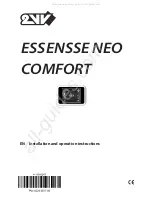
22
IDR-8
User Guide
Communicating Using A TCP/IP Connection
The
iDR-8
uses TCP/IP to communicate with a PC or
distributed network via a CAT5 Ethernet link. It can also
communicate over a dial-up connection using PPP via its
RS232 port. The faster Ethernet connection is recommended
for iDR configuration purposes. Note that the front panel
RS232 port is intended for operating code update. The rear
panel RS232 port is intended for remote interrogation of the
unit via a modem.
You can connect the
iDR-8
directly to your PC using the
Ethernet connection. Alternatively you can plug into a network
so that any networked PC workstation running appropriate
Allen & Heath software can control it. You can have several
iDR-8
units plugged into the same network. This provides the
most flexible solution in today’s world of networked technology.
Each
iDR-8
unit must have its own unique IP address. It needs
to be related to the PC and network address ranges. It must be
within the range of addresses allowed on the Subnet. It must
not conflict with the addresses of other units plugged into the
network. It is also possible that the PC you use to configure
the
iDR-8
is also used with a network at your place of work. If it
is served by a DHCP server then it is likely that it does not have
its own permanent IP address as this is leased by the server.
For these reasons it is very important that you take care when
choosing and setting up the IP addresses.
If you do not have administrative rights to your PC, or
are not familiar with network configuration, or are unsure
which addresses to use then please consult your network
administrator or IT manager.
Some networking terms explained:
LAN
(Local Area Network), the physical
network that links many PCs and related devices
in the same building.
Ethernet
, the most popular worldwide
network system. It is defined by the IEEE802.3
standard and implemented over twisted pair
cable.
CAT5
(Category 5), the standard used for
network cabling and associated connectors.
UTP, STP
(Unshielded Twisted Pair or
Shielded Twisted Pair), the type of cable used.
The cable has four twisted pairs of wires. STP is
shielded to reduce interference pickup.
TCP/IP
(Transmission Control Protocol /
Internet Protocol), a set of layered industry
standard protocols which define network
communication.
IP address
, the unique ‘soft’ address which
identifies each device connected to the network.
It is made up of 4 numbers each from 0 to 255, for
example 192.168.0.1. IP addresses are governed
by the InterNIC organisation.
Subnet
, a subdivision of an organisations
network, splitting it into smaller sections.
Subnet mask
, the number which is used to
identify the subnet, for example 255.255.254.0. It
determines the number of addresses in the
subnet.
MAC address
(Media Access Control), a
unique 12 digit hexadecimal number allocated by
the IEEE to each network hardware device. The
iDR-8
has its number held in its cpu card. A look
up table relates it to the active IP address.
DHCP
(Dynamic Host Configuration
Protocol) A DHCP server automatically allocates
IP addresses to networked devices from a pool of
available addresses. It makes the task of
connecting devices much simpler and prevents
address conflicts. Each device connected should
be set to ‘DHCP ON’, or have its address manually
allocated by the network administrator.
MDI/X
(Medium Dependent Interface), a
switch which determines the electrical connection.
MDI is used when connecting to a network via a
hub. MDIX (MDI crossover) is used when devices
are connected directly instead of through a hub.
Host
, a networked device that provides a
service to a client device.
Client
, a networked device that requests the
services of a computer system or process.
Dial-up connection
, A temporary connection
between devices, for example using a modem
over a standard phone line.
PPP
(Point to Point Protocol), a simple
protocol for data transfer using a dial up
communication over a serial interface.
NETWORK
DR-8
AUDIO MIX PROCESSOR
DR-8
AUDIO MIX PROCESSOR
DR-8
AUDIO MIX PROCESSOR
DIRECT
CAT5
TCP/IP
TCP/IP
Summary of Contents for iDR-8
Page 48: ...48 IDR 8 User Guide ...
















































